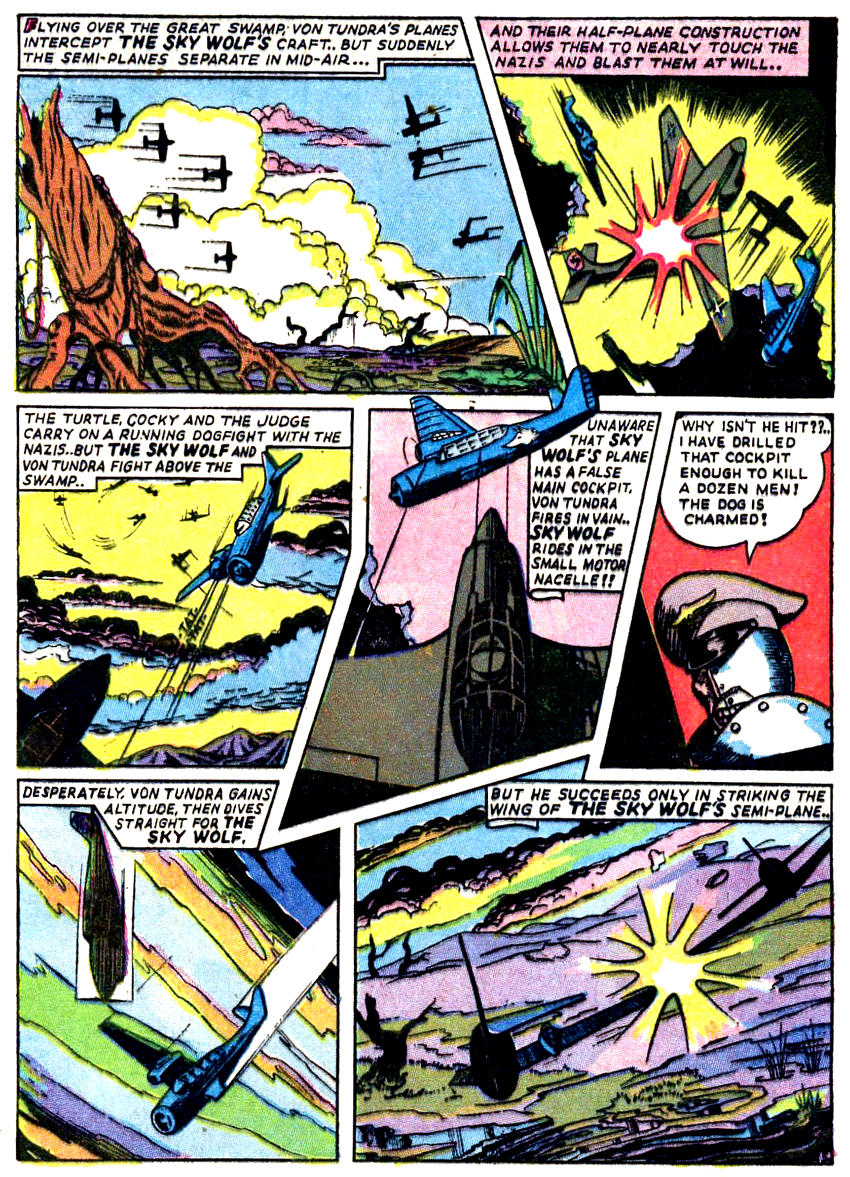The classic story by Sturgeon, published in 1940 in John Campbell’s Unknown, has had an influence far past its initial publication.The novelette was hailed by readers as a classic. As far as I can tell the first “It” copycat was the Heap, who was a German flier of World War I. He died and then was resurrected during the next war as the shambling creature called Heap.
This is the origin of the Heap, told in Air Fighters Comics #3 (1942). The Heap was created by Harry Stein and artist Mort Leav, and probably wasn’t conceived as a permanent addition to the title. After appearing a few times, in 1946 the Heap found his way as a permanent back-up feature (sometimes featured on the cover) until Hillman closed out its comic book line in 1953.
The swamp creatures have come and gone in comics. They are always popular. Heap was, also, I believe, or he wouldn’t have been wandering about in different areas of the world for those years. But to the best of my knowledge all of those swamp creatures go back to Theodore Sturgeon’s incredible original story.
**********
...AND AS A BONUS FEATURE TODAY, HOME BUYING TIPS FROM PANIC AND JACK DAVIS
Today my son and his wife take possession and move into their new home in Western Pennsylvania. Mrs Pappy and I have their children staying with us, which is how we help the process. After all,we live 1600 miles apart (and it is a good excuse for me not to do any furniture moving and heavy lifting).
The last issue of EC Comics’ Panic (1955) featured this funny and well-drawn satire, “House Hunting.” The thing about the best satire is that it never gets too far from reality, just basically pointing out absurdities in any situation, such as looking for a house.






















The incredibly talented Edd Cartier was the illustrator of "It" in the Aug. 1940 issue of Unknown -- so one might see him as the "father" of all the swamp creatures illustrators to follow. Although if I remember correctly, you only see the creature's "hand" in Edd's illo. Still...
ReplyDeleteI went to GCD to see if I could track down a writer for that story in Panic 12, which I remember from my reprint copy.
ReplyDeleteThis is one of the places where EC really flubbed, and their wordiness was their undoing. Why didn't they let Davis -- an incredibly talented comedic story teller -- tell the story? Why, when the salt comes pouring out of the house, do they need text telling you such?
The gag is all in the art. There's nothing funny about "this is a salt house" and, yes, it turns out, it's full of salt. To a 4 year old that might be funny, but what's funny is the art. Yet, the writer doesn't believe enough in the art, and instead describes *what the joke is.* I can't think of anything less funny.
If it was Feldstein, than that's a bit depressing.
Brian, I went to Fred Von Bernewitz and Grant Geissman's Tales of Terror EC index, and they confirm Feldstein as the writer.
ReplyDeleteI agree about the wordiness. If there is a flaw with EC Comics, besides shopworn plots at times, it is over-description.
Look at the noses in that Panic family. I wonder if they're related to Sad Sack.
ReplyDeleteKirk, enormous noses...weak eyes. Didn't even know they were looking at their own house!
ReplyDeleteCome on!Compared to the first story, the Panic one was a masterpiece.
ReplyDeleteAgree with Christophe- the first story was weak in terms of art, plot, dialogue...
ReplyDeleteI also appreciate Brian's view- as a kid I remember feeling inadequate somehow when I couldn't be bothered to read every line in an EC comic, and reading such wordiness is made worse now when doing so via computer screen. But if I may play Devil's Advocate with this particular story, in defence of Feldstein it would appear he's doing a send-up of the 1950s-style versions of today's info-commercials. You need to read it as if channelling those old science documentaries you'd watch in class. I don't think it was done out of contempt for the artwork, but rather as a counterpart. A contempt for the pretentious narrator perhaps. That's why the BBC has long ditched the plummy accents we associate with it from the old Pathe newsreels.
Keir, I have something of a mental edit when it comes to wordiness in comic books. I don't read every word. It's not just laziness. I believe I should not need lengthy captions. If a comic book story can't be told through pictures and dialogue then it has failed.
ReplyDeleteWhen I see a movie I don't expect to have a narrator explain a scene. I believe modern comics readers and movie goers understand the language of each and can figure out what is going on.